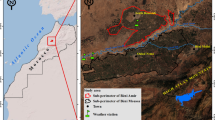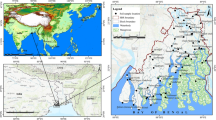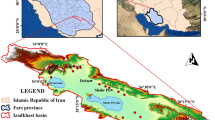Abstract
This study presents an integrated study of expansion process of salinized land in Basrah Province, a typical salt-affected area in southern parts of Iraq, by using geo-information techniques. Satellite images (Landsat TM 1990) and thematic maps (ETM 2003) were used to provide comprehensive views of surface conditions such as vegetation cover and salinization detection. With ERDAS software, the normalized differential salinity index (NDSI) and salinity index (SI) were computed and then evaluated for soil degradation by salinization. ARC/INFO software was used along with field observation data (global positioning system) for analysis. During the past 13 years, the salinized land in study area increased by 6 579.1 km2 and in 2003 covered 34.5% of the total area; in the meantime, vegetation cover has decreased by 4 595.9 km2 and in 2003 covers only 24.1% of the study area. Environmental changes show that, between 1990 and 2003, 37.5% of vegetation cover and 45.9% of marshlands were transformed into salty meadow and wet salty crust, respectively. In addition, there was 16.6% of sand lands converted into dry puffy salty crust. Results using spatial analysis methods showed that 7 894.9 km2 (41.4%) of land had no risk of environment degradation by soil salinity, 4 595.9 km2 (24.1%) had slight risk, 4 042.8 km2 (21.2%) had moderate risk, and 2 536.3 km2 (13.3%) of the total land area was at a high risk of environment degradation by soil salinity. In conclusion, the study area was exposed to a high risk of soil salinity.
Similar content being viewed by others
References Cited
Awasthi, K. D., Sitaula, B. K., Singh, B. R., et al., 2002. Land-Use Change in two Nepalese Watersheds: GIS and Geomorphometric Analysis. Land Degradation & Development, 13(6): 495–513, doi:10.1002/ldr.538
Cayuela, E., Estan, M. T., Parra, M., et al., 2001. NaCl Pre-Treatment at the Seedling Stage Enhances Fruit Yield of Tomato Plants Irrigated with Salt Water. Plant and Soil, 230(2): 231–238
Collado, A. D., Chuvieco, E., Camarasa, A., 2002. Satellite Remote Sensing Analysis to Monitor Desertification Processes in the Crop-Rangeland Boundary of Argentina. Journal of Arid Environments, 52(1): 121–133
Dehaan, R., Taylor, G. R., 2003. Image-Derived Spectral Endmembers as Indicators of Salinization. International Journal of Remote Sensing, 24(4): 775–794
De Jong, S. M., 1994. Derivation of Vegetative Variables from a Landsat TM Image for Modeling Soil-Erosion. Earth Surface Processes and Landforms, 19(2): 165–178, doi:10.1002/esp.3290190207
Dymond, J. R., Begue, A., Loseen, D., 2001. Monitoring Land at Regional and National Scales and the Role of Remote Sensing. International Journal of Applied Earth Observation and Geoinformation, 3(2): 162–175
Farifteh, J., Farshad, A., George, R. J., 2006. Assessing Salt Affected Soils Using Remote Sensing, Solute Modeling, and Geophysics. Geoderma, 130(3–4): 191–206
Goetz, A. F. H., Herring, M., 1989. The High Resolution Imaging Spectrometer (HIRIS) for EOS. IEEE Transactions on Geoscience and Remote Sensing, 27(2): 136–144
Goetz, A. F., Vane, G., Soloman, J. E., et al., 1985. Imaging Spectrometry for Earth Remote Sensing. Science, 228(4704): 1147–1153
Hick, P. T., Russell, W. G. R., 1990. Some Spectral Considerations for Remote Sensing of Soil Salinity. Australian Journal of Soil Research, 28(3): 417–431, doi:10.1071/SR9900417
Jabbar, M. T., Chen, X. L., 2006. Land Degradation Assessment with the Aid of Geo-Information Techniques. Journal of Earth Processes and Landforms, 31(6): 777–784, doi:10.1002/esp.1298
Jabbar, M. T., Shi, Z. H., Wang, T. W., et al., 2006. Vegetation Change Prediction with Geo-Information Techniques in the Three Gorges Area of China. Pedosphere, 16(4): 457–467
Jabbar, M. T., Al Bassam, B. F., Hu, G. D., 2004. Application of Remote Sensing and GIS in Study of Aeolian Deposits Distribution and Sand Dune Movements in Northern Part of Shaanxi Province, China. Journal of China University of Geosciences, 15(Suppl.): 85–91
Jabbar, M. T., 2003. Using Remote Sensing and GIS Techniques to Study Soil Degradation Processes in North Shaanxi Province, China. Journal of China University of Geosciences, 14(4): 356–362
Jabbar, M. T., Hu, G. D., Chen, J. G., 2002. Study of Sand Dunes and Their Effect on Desertification of Cultivated Lands in Shaanxi Province, China—Using Remote Sensing Techniques. Journal of China University of Geosciences, 13(3): 234–239
Jabbar, M. T., 2001. Soil Loss by Wind Erosion for Three Different Textured Soils Treated with Polyacrylamide and Crude Oil, Iraq. Journal of China University of Geosciences, 12(2): 113–116
Jia, B. Q., Zhang, Z. Q., Ci, L. J., et al., 2004. Oasis Land-Use Dynamics and Its Influence on the Oasis Environment in Xinjiang, China. Journal of Arid Environments, 56(1): 11–26
Lambin, E. F., Turner, B. L., Helmut, J. G., et al., 2001. The Causes of Land-Use and Land-Cover Change: Moving beyond the Myths. Global Environmental Change, 11(3): 261–269
Lichtenberg, E., Ding, C., 2008. Assessing Farmland Protection Policy in China. Land Use Policy, 25(1): 59–68
Metternicht, G. I., Zinck, J. A., 2003. Remote Sensing of Soil Salinity: Potentials and Constrains. Remote Sensing of Environment, 85(1): 1–20
Mougenot, B., Pouget, M., Epema, G. F., 1993. Remote Sensing of Salt Affected Soils. Remote Sensing Reviews, 7(3–4): 241–259
Purevdorj, T. S., Tatelshi, R., Ishiyama, T., et al., 1998. Relationships between Percent Vegetation Cover and Vegetation Indices. International Journal of Remote Sensing, 19(18): 3519–3535
Shen, R. P., Kheoruenromne, I., 2003. Monitoring Land Use Dynamics in Chanthaburi Province of Thailand Using Digital Remotely Sensing Images. Pedosphere, 13(2): 157–164
Tripathi, N. K., Rai, B. K., Dwivedi, P., 1997. Spatial Modeling of Soil Alkalinity in GIS Environment Using IRS Data. 18th Asian Conference on Remote Sensing, Kualalampur. 81–86
U.S. Salinity Laboratory Staff, 1954. Diagnosis and Improvement of Saline and Alkali Soils. In: Richards, L. A., ed., USDA Handbook. U.S. Gov. Print. Office, Washington. 60: 7–33
UNEP, 2001. The Mesopotamian Marshlands: The Demise of an Ecosystem. Early Warning and Technical Assessment Report, UNEP/DEWA/TR.01-3. http://www.grid.unep.ch/activities/sustainable/tigris/mesopotamia.pdf (accessed May 2003)
Verbeiren, S., Eerens, H., Piccard, I., et al., 2008. Orshoven, Sub-Pixel Classification of SPOT-VEGETATION Time Series for the Assessment of Regional Crop Areas in Belgium. International Journal of Applied Earth Observation and Geoinformation, 10(4): 486–497
Verma, K. S., Saxena, R. K., Barthwal, A. K., et al., 1994. Remote Sensing Technique for Mapping Salt Affected Soils. International Journal of Remote Sensing, 15(9): 1901–1914, doi:10.1080/01431169408954215
Vitousek, P. M., Mooney, H. A., Lubchenco, J., et al., 1997. Human Domination of Earth’s Ecosystems. Science, 277(5325): 494–499
Author information
Authors and Affiliations
Corresponding author
Additional information
This study was supported by the Basrah University, Iraq and the Outstanding Doctorate Thesis Foundation of Huazhong University of Science and Technology, the Youth Chenguang Project of Science and Technology of Wuhan City of China (Nos. 20015005037 and 20055003059-34), and the Natural Science Foundation of Hubei Province (No. 2005ABA047).
Rights and permissions
About this article
Cite this article
Jabbar, M.T., Zhou, J. Assessment of soil salinity risk on the agricultural area in Basrah Province, Iraq: Using remote sensing and GIS techniques. J. Earth Sci. 23, 881–891 (2012). https://doi.org/10.1007/s12583-012-0299-5
Received:
Accepted:
Published:
Issue Date:
DOI: https://doi.org/10.1007/s12583-012-0299-5




